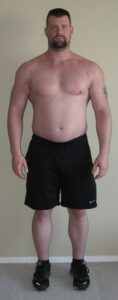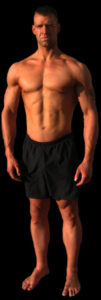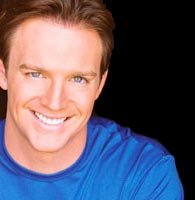Chad Waterbury on Why Some Fat Loss Plans Fail Miserably – and Why Body of Fire is a Better Approach
Today, we’re fortunate to have an interview with Chad Waterbury.
EC: Chad, thanks for agreeing to this interview for the site. It’s hard to believe that EricCressey.com has been “live” since 2006, and this is the first time we’ve gotten you on-board for a feature. Most of my readers are probably familiar with you already, but what have you been up to lately?
CW: First off, I want to say that it’s a pleasure to be here. You offer top-notch information to a wide variety of clients and that’s why I’m happy to do this interview. This is one of the few websites that I read on a regular basis.
Over the last few years, since moving to Los Angeles, I’ve gotten back to training more people one-on-one. In this town, it’s all about fat loss. People want to get lean and ripped, like, yesterday. In LA, immediate gratification isn’t fast enough. So I’ve spent time really honing my training and nutrition parameters to help people burn fat in record time.
I’ve also been working with a lot of professional fighters. There’s no greater challenge than developing a fighter because he needs to build elite levels of strength, endurance, and mobility at the same time. The cool part is that my work with fighters – and the parameters I use for burning fat – actually coalesce. Why? It’s simple: the quickest way to get a leaner, stronger body is to train more like an athlete – especially a fighter. So my challenge was to create a system to get non-athletes to experience the same results that my athletes, such as Ralek Gracie, get when training with me personally.
EC: Gracie’s rocking your “Body of FIRE” logo on his banner at the beginning of this clip; let’s talk about that. You’ve got a new fat loss e-book out (Body of F.I.R.E.). Besides the obvious fact that a lot of people are…well…fat, what inspired you to write it?
CW: Honestly, I was getting tired of hearing outrageous claims from trainers who’ve never transformed anyone. This industry is replete with self-proclaimed experts. Now, I’m certainly not against the idea of making money off your information, but when the sales pitch is exaggerated to the point of hysteria it becomes a little too much to stomach. It’s funny because people often associate me with methods that are solely intended to build size and strength. In reality, I have more experience with training people for fat loss than anything else.
So I took it upon myself to create a system that will transform people faster than they ever thought possible. That’s why I created my new Body of F.I.R.E. program. In my experience, nothing transforms a person quicker than an effectively designed Full-body, Intense, Resistance Exercise program – hence the acronym.
However, I didn’t want to make a program that was only for advanced athletes, so I took a lot of time tweaking the parameters so anyone can get incredible results on the program.
EC: Along those same lines, where are most people falling short on the fat loss front? Why isn’t the status quo getting the job done?
CW: This is easy to answer. The first reason why people don’t lose fat, and keep it off, is because they don’t know how to eat to stimulate their metabolism. Most diets shut down fat burning and make people feel miserable.
The second reason is due to their training program. It’s imperative to stimulate as many muscle fibers as possible with full-body workouts while keeping the rest periods to a minimum in order to generate a large cardiovascular response.
The third component is with their progression plan, or lack thereof. The only way to make your body lose fat week after week is to make it to do work without burning out your nervous system. Building athleticism is a key to making this work.
Finally, tissue health is probably the most underrated and unappreciated aspect of body transformation. There are simple steps you can take to keep your joints healthy, and this is essential to sticking with a program. There are a lot of crazy programs out there that quickly impose an insane amount of stress on the joints. If you get injured, your fat loss endeavor immediately comes to a screeching halt.
EC: Let’s talk about the program itself. What’s unique about it that sets it apart from other fat loss methods that may fall short?
CW: Quickly transforming your body starts with the right diet. You’ll never lose fat unless your nutrition program focuses on foods that are high in nutrients but low in calories. It’s all about food quality. You can eat an entire bag of potato chips because they contain no real nutrients. Therefore, your brain never gets the memo that your body is satisfied. However, you’d never be able to finish the same amount of calories from, say, blueberries or broccoli because your brain quickly gets the signal that your body is getting the nutrients it needs to support your metabolism. Bottom line: the only way to see your abs is to get your diet in order first.
The second component is with your training program. As I mentioned, it’s essential to train in a way that induces the largest metabolic cost that exercise can create. Tabata’s research taught us that we need to think less about the metabolic changes that are occurring during a workout and focus more on what’s happening after you leave the gym. An hour jog only burns calories while you’re doing it, plus it’s very hard on your hips, knees, and ankles. High intensity cardio, on the other hand, will stimulate your metabolism to keep burning calories long after you stop training – if you know how to do it right. Instead of running on a treadmill, focus on full-body circuits such as split jacks, jumping jacks, and burpees that are performed for multiple rounds with minimal rest.
With regard to weight training, it’s important to do three things. First, for every other workout, lift loads that are heavy enough to recruit all of your muscle fibers. Most people lose size and strength on a fat loss plan because they focus on light, high-rep weight training exercises that are performed to failure. This is a travesty because it’s not optimal for maximum muscle fiber recruitment. Focus on weights that are between a 6-12 repetition maximum, and accelerate all of your lifts. This ensures that you’re recruiting all of your muscle fibers with every rep. As the saying goes: if you don’t use it, you lose it. A full-body circuit comprised of an upper body push, an upper body pull, a lower body exercise, and a core exercise is outstanding for creating a huge metabolic cost when the rest periods are kept to a minimum.
From there, I have my clients perform “cardio strength” exercises. These are exercises that don’t require as much load as a strength circuit, but they can still recruit all of your muscle fibers when performed correctly. For example, I like to pair up the kettlebell swing with a push-up for descending reps. You’ll start with, say, 13 reps of the swing and then you’ll drop to the floor and knock out 13 push-ups. Then you’ll jump back to your feet and do 12 swings followed by 12 push-ups. Next it’s 11 swings followed by 11 push-ups. You’ll continue with this sequence until you reach one rep for each exercise. When you perform each exercise at top speed, and when you keep rest to a minimum, it’s awesome for burning fat while boosting athleticism.
The third essential component of body transformation comes from an effective progression plan. Many people stop getting results on a fat loss program after a few weeks because their parameters are stagnant. You must force your body to do more work over time. You don’t need to keep adding weight to your lifts. Instead, focus on adding a rep or set, or increase your work interval, or shorten your rest periods by five seconds with each workout. This ensures that your metabolism is constantly being challenged. In my new program, I use a combination of these progression methods in each phase.
EC: The thing I noticed right away is the dedicated focus to staying healthy with good soft tissue work and a focus on mobility and athletic movement. It seems like a lot of fat loss programs out there are all about just making people move a ton to tire them out and burn calories – but there is rarely (if ever) a focus on the quality of movement. Inevitably, exercise technique goes down the crapper and many folks wind up injured (in addition to being raging a**holes from caloric deprivation). Can you speak a bit to how you attacked this aspect of the program?
CW: You’re right, Eric, getting the most out of your workouts comes from quality of movement. And getting the most out of your movements comes from having healthy joints that are in balance. Just like high quality foods are essential to boosting your metabolism, so are the exercises. I spent a lot of time developing the exercise guide in this resource by including big, high-resolution pictures along with many tips and technique guidelines to ensure that everyone is doing each exercise perfectly.
Furthermore, each workout starts with a few mobility exercises. Most people are stiffest in their ankles, hips, T-spine, and shoulders so it’s important to mobilize those areas before you start training. The good news is that it doesn’t take long – just a few minutes when you know what to do. And each workout ends with a few, key stretches for the same areas. This is great insurance to keep you on track. A program is only as good as the corrective exercises it contains to keep you from throwing your joints out of whack.
EC: Let’s talk nutrition. What can readers expect on that front in Body of Fire?
CW: The nutrition program is as effective as it is user-friendly. The first step, as I mentioned, comes from replacing low-quality foods in your current eating plan with nutrient-dense, low-calories foods. The second step is to control insulin and add in certain, key nutrients that research has shown to have the greatest impact on increasing your metabolism. You must eat frequently, every 3-4 hours, and most people know that. But what might surprise people is that front loading your calories, where breakfast is your highest calorie meal and dinner is the lowest, is a simple way to supercharge your metabolism and burn fat. The third component comes from your workout nutrition. If you take branched-chain amino acids in the right amounts, before and after training, along with a specific post-workout feeding you’ll accelerate fat burning, recovery, and performance.
The nutrition plan, when paired with the workouts I outline in the program, produce incredible results. My client, Jon, lost over 40 pounds of fat on the program. Since he’s an athlete, he couldn’t afford to lose any size and strength. As you can see from the before and after pictures, he created what many guys might consider to be the ultimate body. I’ll concede that he shaved, tanned, and lost his shoes, but I think the rest speaks for itself.


EC: Not too shabby at all! Thanks a lot for taking the time to answer my questions, Chad. Where can readers find out more about the new product?
CW: Just head over to BodyofFire.com and check it out while the introductory price is still in effect. This program is unlike anything I’ve written about in any of my books or articles. I’ve never spent as much time on a project as I have on the this system. No stone has been left unturned.






